Skulls Unlimited cleans over 50,000 skulls a year.
Learn More!

Where 'how greasy a human is' is part of the job
At Skulls Unlimited, things can get kind of gross, no bones about it
Oct 30, 2006
The Associated Press
OKLAHOMA CITY - On one table, a worker places the final touches on a human skeleton, with the head still separated from the rest of the bones. In another corner sit three large whale skulls, one weighing about a ton.
Nearby, another worker carves — there’s no delicate way to put this — flesh, muscle and other tissue off a bear skull. Enter an adjoining room, and one is greeted with the sight of aquarium tanks full of dermestid beetles swarming over animal skulls, eating the last bits of tissue left on the skull bones.
Then there’s the distinct, yet difficult to describe, smell that permeates the building — think something between a slaughterhouse and rotting meat.
No Halloween haunted house has anything on the people who work at Skulls Unlimited International, an Oklahoma City company that bills itself as the world’s leading supplier of osteological specimens.
“If I don’t want to talk to (other people), I tell them I manage a museum exhibit company,” said Eric Humphries, who’s worked at the company for 14 years and now is its production manager. “If I want to talk to them, I tell them I clean skulls and skeletons for a living.”
Jay Villemarette, the company’s founder, dates his fascination with skulls to his youth, when he found a dog skull in some woods. His interest in skulls and science grew through his high school years in the Oklahoma City suburb of Moore.
When his job as an auto body mechanic ended in the mid-1980s, he decided to turn his hobby of cleaning skulls into a business. Skulls Unlimited began in 1986 in the kitchen of his home, where he would boil skulls — a process that helped remove attached tissues — on the family stove. He said that didn’t exactly thrill his wife, but the success of the business eventually allowed her to stay at home with the couple’s four children, two of which work with their father.
Skulls Unlimited takes skulls and skeletons — human and animal — strips them of tissue, sanitizes them and sells them. Almost all of the company’s business in human bones comes from museums and educational groups, with prices starting at $349 for a human skull to $3,700 for a full skeleton.
“We’re probably one of the few suppliers in the country that has real human skulls,” Villemarette said.
The company also has a catalog and offers more than 700 types of animal skulls for sale, and people routinely ship the company animal skulls for preparation.
Villemarette, 41, said Skulls Unlimited’s reputation has opened doors, allowing the company access to rare and unique skulls — such as a killer whale it obtained after the death of the animal, which once was displayed at Sea World in San Antonio. Zoos and animal parks also have sent the company animals after their deaths.
In a storage area, dozens of human skulls — which have been legally imported from China — sit on shelves.
That part of the business sometimes brings questions about the legalities of it all, and Villemarette said that he operates within all applicable state and federal laws. The facility is regulated as a rendering plant. Any necessary disposal of human material is handled by a medical waste company.
Villemarette estimates the company has prepared as many as 500,000 mammal skulls.
The process isn’t for the squeamish. Once a set of bones arrives at the company, workers carve off as much tissue as they can by hand. Then the dermestid beetles do the rest. Villemarette gladly removes one tank in which the bugs are feasting on tissue that remains on the skulls of two alligators, two dogs, a grizzly bear and a gazelle, picking up one of the skulls to offer an onlooker a better view of the process.
Flies can be a problem around the skulls, as a fly strip loaded down with the dead pests attests. Biohazard signs are numerous, as skulls in various states of preparation lie scattered on the floor.
Naturally, the question arises about the facility’s unique aroma.
“I’ve been waist-deep in a dead hippopotamus, and I’d rather do that than change diapers,” Humphries said. “You always notice (the smell), but you do get used to it.”
As if to offer proof, one of Villemarette’s sons casually walks by the rendering tables, munching on a bag of chips and drinking a soda.
Villemarette said eating chips, in a roundabout way, presents a problem when a human skeleton is being processed. The beetles don’t like to eat human tissue, he said, because of the volume of grease in human bones and meat.
“It’s just nasty,” he said. “We will clean human (bones), but we’d just as soon not. There’s kind of an ‘ick’ factor, you know? It’s just not quite the same. The ‘ick’ factor on dismembering a human body and putting the meat into a biohazardous bucket to be rendered, and the oils that drip off onto that floor,” he said, seemingly not wanting to finish the thought. “Some people would say that I am exaggerating when I say how greasy a human is. I am not exaggerating. It is nasty.”
Even as his company cranks out the skulls and skeletons, Villemarette works on other projects. He’s in the process of writing a book that will feature the skeletons of the 442 mammals indigenous to North America. He also hopes to open the Museum of Osteology next year in south Oklahoma City that will include skeletons of mammals both common and exotic, such as giraffes, whales, elephants and the endangered black-footed ferret.
He can’t foresee a day when he’d want to do anything else.
“I’m still having fun,” Villemarette said. “I love what I do.”

Leave a comment